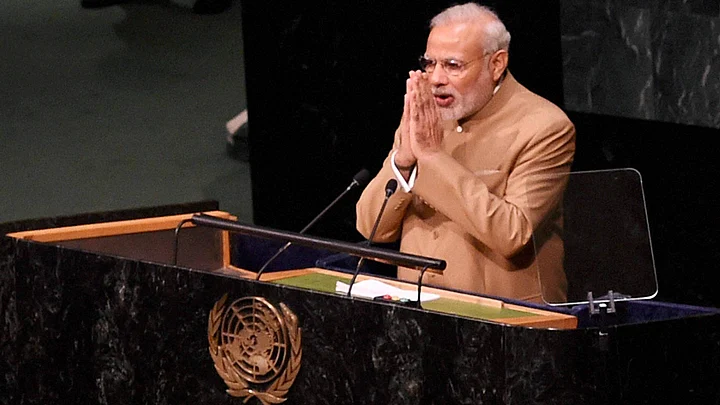Next week, as world leaders starting with President Obama perform their annual ritual of addressing the United Nations General Assembly, India’s Prime Minister Narendra Modi won’t be there. That’s because he will already have spoken to the world from the same podium the previous Friday (today, as I write). But rather than the usual rhetoric about world peace, and the familiar list of issues that feature in every world leader’s grab bag, Mr Modi spoke at the pre-Assembly meeting convened to endorse the Sustainable Development Goals (SDGs) – the successor to the Millennium Development Goals, which have reached the target date of 2015 only partially fulfilled.
The SDGs are an intimidatingly long list of targets for social and economic development – 17 of them, with 169 sub-goals laying out specific indicators to be achieved by developing countries. They span a wide range of human need and, if fulfilled, could transform the lives of a majority of human beings on the planet. The British charity Save the Children has already, with pardonable hyperbole, declared they would save 6500 lives a day. They are certainly worth adopting and worth pursuing, for the next fifteen years till 2030, at which point a fresh round of global development aspirations will no doubt be adopted.
Fizz Has Gone
So Mr Modi was in the right place for an Indian Prime Minister, with so many of the world’s most unfortunate citizenry inhabiting his own country – India has more poor people, more illiterates, more victims of TB, more blind people than any other country (and there are several other lists which we unenviably top).
But it’s a far cry from his triumphant visit to New York in 2014, and American and global media coverage of the no-longer new Indian Prime Minister is much more muted this time around. Indeed, as far as public attention goes, he has been significantly eclipsed by President Xi Jinping of China, who is also in America at the same time. Clearly, he appears to have cut something less of a swathe through the American public or the UN itself. Far from the hysterical cheers of his fans in Madison Square Garden last time, and even from the company of actor Hugh Jackman before 60,000 concert-goers in Central Park, Mr Modi found himself in decidedly more prosaic environments this time.
He spoke of India’s commitment to the environment, to international co-operation and to poverty alleviation in terms familiar to long-time students of Indian foreign policy. So remarkably similar were the echoes of speeches by his predecessors at previous UN podiums that when he declared at the UN he was “dreaming of a world that is free of poverty,” one almost expected him to thump the lectern and declaim “Garibi Hatao!”
Where is the Product?
- In terms of public attention, President Xi Jinping of China has taken a lead compared to Prime Minister Modi
- Modi’s speech on India’s commitment to environment and international cooperation was plain rhetoric
- Time now for Modi to put his money where his mouth is by improving ease of doing business rankings
- Modi’s problem in America is the perception of credibility deficit
- The US has begun to believe that behind the glitzy packaging, there is no substantive product on offer
Credibility Deficit
If New York 2014 was all flash and celebration, New York 2015 was, inevitably, about the dull but necessary reiteration of established Indian verities on development. Before Modi arrived, his senior aides had already held the first Strategic and Commercial Dialogue between the two countries. But while strategic co-operation was enunciated in the substance-free bromides that have become a cliché in the Indo-US dialogue process of late, it was difficult to escape the sense that the two countries were not on the same page when it came to trade.
As US Commerce Secretary Penny Pritzker repeatedly pointed out, India is still only the 11th largest trading partner and the 18th largest export market for the US. Those rankings won’t improve until Mr Modi puts his money where his rhetorical mouth is and actually moves to improve the ease of doing business in India – one more issue on which the gap between rhetoric and reality is widening. India actually slipped on Mr Modi’s watch to a dismal 142nd out of 189 countries in the World Bank’s ease of doing business rankings.
Mr Modi’s fundamental problem in America remains his growing credibility deficit in India – the perception that he talks a good game but delivers little (or, in the marvellous Texan phrase about cowboy braggadocio, that he is “all hat and no cattle”.) He is an excellent salesman for his version of India, but Americans are increasingly beginning to feel that behind the packaging there is no product.
Mr Modi now goes west, taking his sales pitch to Silicon Valley, where he will market his wares to cutting-edge tech firms Adobe, Facebook, Google and Tesla. He will recite all the mantras of his advertising-savvy regime, from “Make in India” to “Digital India” to “StartUp India” (and now StandUp India).
(Former UN under-secretary-general, Shashi Tharoor is a Congress MP and author)
(At The Quint, we question everything. Play an active role in shaping our journalism by becoming a member today.)
